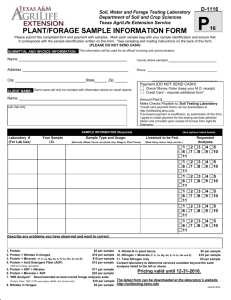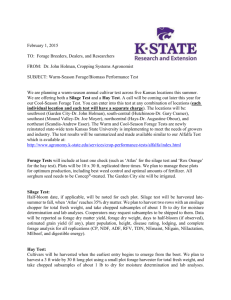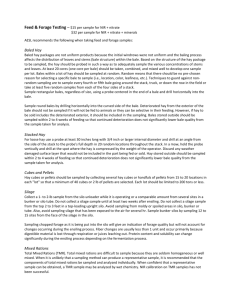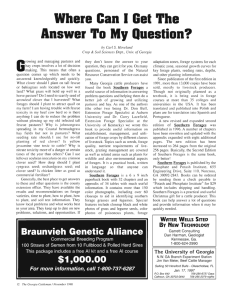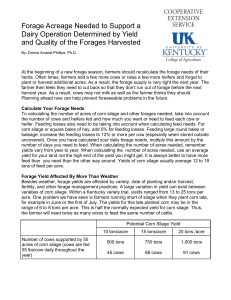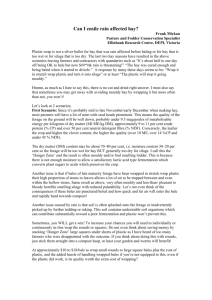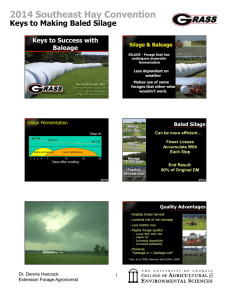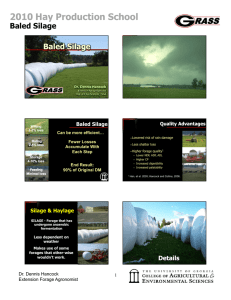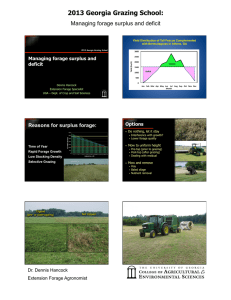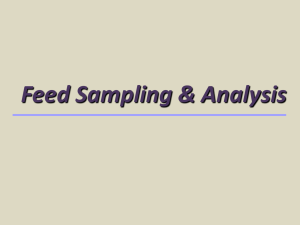Do you have enough forage this year? (Word)
advertisement
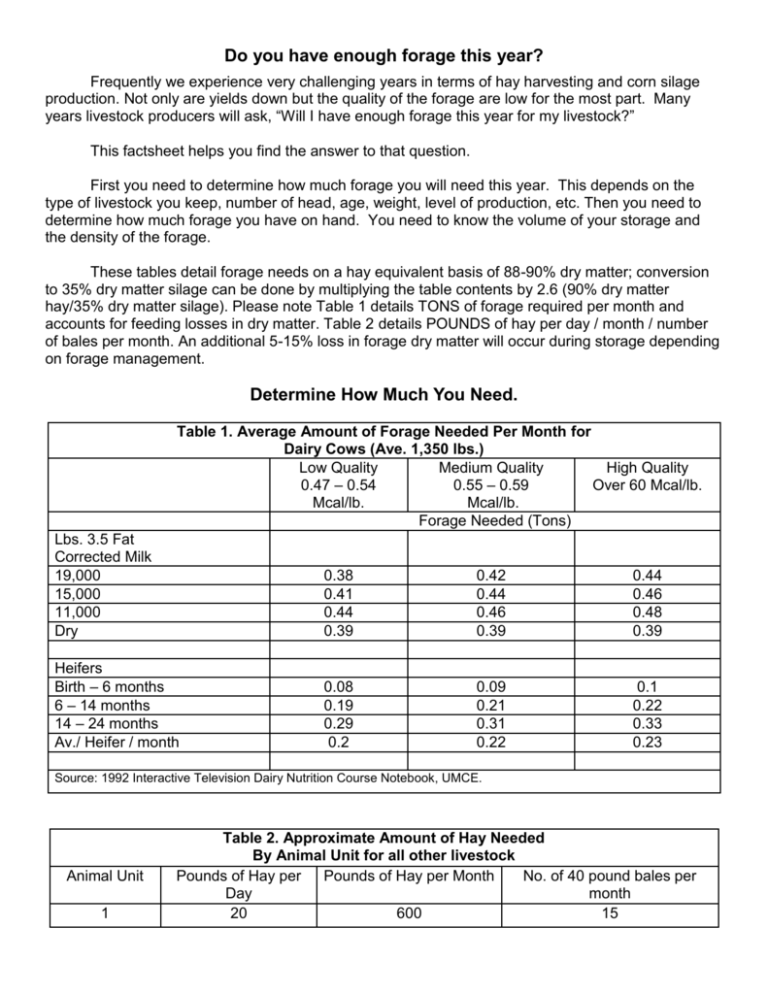
Do you have enough forage this year? Frequently we experience very challenging years in terms of hay harvesting and corn silage production. Not only are yields down but the quality of the forage are low for the most part. Many years livestock producers will ask, “Will I have enough forage this year for my livestock?” This factsheet helps you find the answer to that question. First you need to determine how much forage you will need this year. This depends on the type of livestock you keep, number of head, age, weight, level of production, etc. Then you need to determine how much forage you have on hand. You need to know the volume of your storage and the density of the forage. These tables detail forage needs on a hay equivalent basis of 88-90% dry matter; conversion to 35% dry matter silage can be done by multiplying the table contents by 2.6 (90% dry matter hay/35% dry matter silage). Please note Table 1 details TONS of forage required per month and accounts for feeding losses in dry matter. Table 2 details POUNDS of hay per day / month / number of bales per month. An additional 5-15% loss in forage dry matter will occur during storage depending on forage management. Determine How Much You Need. Table 1. Average Amount of Forage Needed Per Month for Dairy Cows (Ave. 1,350 lbs.) Low Quality Medium Quality High Quality 0.47 – 0.54 0.55 – 0.59 Over 60 Mcal/lb. Mcal/lb. Mcal/lb. Forage Needed (Tons) Lbs. 3.5 Fat Corrected Milk 19,000 15,000 11,000 Dry 0.38 0.41 0.44 0.39 0.42 0.44 0.46 0.39 0.44 0.46 0.48 0.39 Heifers Birth – 6 months 6 – 14 months 14 – 24 months Av./ Heifer / month 0.08 0.19 0.29 0.2 0.09 0.21 0.31 0.22 0.1 0.22 0.33 0.23 Source: 1992 Interactive Television Dairy Nutrition Course Notebook, UMCE. Animal Unit 1 Table 2. Approximate Amount of Hay Needed By Animal Unit for all other livestock Pounds of Hay per Pounds of Hay per Month No. of 40 pound bales per Day month 20 600 15 2 3 40 60 1200 1800 30 45 Table 3. Animal Units It is assumed that one mature cow represents an animal unit or 1,000 pounds. The comparative feed consumption of other age groups or species of animals determines the proportion of an animal unit that they represent. Type of Livestock Beef Cattle: Cow, with or without unweaned calf at side Heifer, 2 years old or older Bull, 2 years old or older Young Cattle, 1 to 2 years Weaned calves to yearling Horses: Draft Horse Light Horse, mature Light Horse, yearling Weanling colt or filly Sheep: 5 Mature ewes, with or without lambs at side 5 Rams, 2 years old or older 5 Yearlings 5 Weaned lambs or yearlings Animal Unit 1.0 1.0 1.3 0.8 0.6 1.7 1.3 1.0 0.75 1.0 1.3 0.8 0.6 Source: Feeds and Nutrition, M.E. Ensminger, J.E. Oldfield, W.W. Heinemann, Ensminger Publishing Co., 1990. Determine How Much You Have: Table 4. Hay Shed Capacity Width, Feet 24 30 With 20’ High Sidewalls Baled Hay Tons/Foot of Length 2.0 2.6 36 3.1 40 48 3.4 4.0 Density Values Alfalfa Cu. Ft./ Ton 200 – 330 Lbs./ Cu. Ft. 6 – 10 Non-legume 250 - 330 6–8 Straw 400 – 500 4–5 Source: Dairy Housing Handbook, MWPS – 7 Table 5. Bunker Silo Capacities Average Depth of Silage in Bunker Average Width 8 ft. 12 ft. 16 ft. Tons Dry Matter per One Foot of Length 12 ft 15 ft 20 ft 30 ft 40 ft 0.53 0.66 0.90 1.3 1.8 0.78 1.0 1.3 2.0 2.6 1.1 1.3 1.8 2.6 3.5 1.3 1.7 2.2 3.3 4.4 50 ft 2.2 3.3 4.4 5.5 20 ft. Source: Managing Dairy Feed Inventory, University of Wisconsin, W. T. Howard, V. Wagner, and H. Larsen. Table 6 Round Bale vs. Square Bale Equivalent Number of Square Bales Size of Round Bale 40 lb. Bale 50 lb. Bale 60 lb. Bale 4’ Diameter 15 12 10 (600 lb.) 5’ Diameter 25 20 16-2/3 (1,000 lb.) 6’ Diameter 35 28 23 -1/3 (1,400 lb.) Note: Losses due to weathering can vary from 11% to 44% for round bales left outside Table 7. Approximate Dry Matter Capacities of Tower Silos (Tons) Silo Height (ft) Silo Diameter (ft) 12 16 20 24 24 15 27 43 61 32 23 41 65 93 40 32 57 89 127 48 42 74 115 166 56 93 144 207 64 174 250 72 293 80 334 28 83 127 173 226 282 340 400 455 *Capacities allow one foot unused depth for settling in silo up to 30 ft high, and one additional foot for each 10 ft beyond 30 ft height. Source: ASAE (1985) as presented in, Silage and Hay Preservation, NRAES – 5. Plan for this Year: Consider a late harvest on some fields Purchase forage from other farmers (purchase now, don’t wait until late spring) Feed more grain and less hay Cull low producing animals Reduce herd size Feed high fiber byproduct feeds to extend forage supplies Plan for Next Year: Fertility Management Soil test hay fields now Maintain soil pH at 6.0 Top dress with phosphorus and potash as required Apply potash this fall to legume fields Apply nitrogen in early spring to fields with over 75% grass Apply nitrogen fertilizer to grass fields after first cutting, if cut before July 1 st. Harvest Management Plan to start harvest the first week in June (have supplies and equipment ready June 1st) Plan to harvest second cutting Consider implementing an intensive grazing program and extend the grazing season into late fall and early spring to reduce stored forage needs. Prepared by: Donna R. Coffin, Extension Educator and Gary Anderson, Extension Specialist, University of Maine Cooperative Extension, Reviewed by Rick Kersbergen, Extension Educator, Gary Anderson, Extension Specialist and David Marcinkowski, Extension Specialist .
